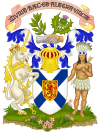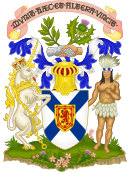
Neil McLeod was a Prince Edward Island lawyer, judge, politician, the fifth premier, and Leader of the Opposition during the amalgamation of the Prince Edward Island legislature. He was born at Uigg on the island to Roderick McLeod and Flora McDonald, Baptist immigrants from the Isle of Skye in Scotland. He was educated at the Uigg Grammar School and in Wolfville, Nova Scotia, articled in law at Charlottetown and was called to the bar in 1873. Four years later, his marriage to the beloved Isabella Jane Adelia Hayden, the Methodist granddaughter to Irish Roman Catholic immigrant and merchant John Roach Bourke, furthered Gaelic intersections among Islander cultural enclaves. McLeod was the child of immigrants from the Isle of Skye and transcriptions identified him as both "Neil McLeod" and "Neil MacLeod", in publications as well as legal documents, after the 1886 election of Angus MacLeod. Historians continue to research his positions on the 1882 replacement of French-language texts with bilingual readers for French Acadians, late nineteenth-century prohibitions on Canadian Gaelic, and corporal punishment in Prince Edward Island schools. During this period, McLeod practiced law with partner Edward Jarvis Hodgson before joining the McLeod, Morson, and McQuarrie law firm. He also served as Commissioner for the Poor House and as a "trustee" to the public Prince Edward Island Hospital for the Insane, which replaced the Lunatic Asylum following a Grand Jury inquest. In 2019, mental health officer and occupational therapist Tina Pranger examined the presents and pasts of the Hillsborough Hospital, providing a summation of previous assessments of the inquest by historians and curators.

The Legislative Assembly of Ontario is the legislative chamber of the Canadian province of Ontario. Its elected members are known as Members of Provincial Parliament (MPPs). Bills passed by the Legislative Assembly are given royal assent by the lieutenant governor of Ontario to become law. Together, the Legislative Assembly and Lieutenant Governor make up the unicameral Legislature of Ontario or Parliament of Ontario. The assembly meets at the Ontario Legislative Building at Queen's Park in the provincial capital of Toronto.

The Nova Scotia House of Assembly, or Legislative Assembly, is the deliberative assembly of the General Assembly of Nova Scotia. The assembly is the oldest in Canada, having first sat in 1758; in 1848, it was the site of the first responsible government in the British Empire. Bills passed by the House of Assembly are given royal assent by the lieutenant governor of Nova Scotia in the name of the King in Right of Nova Scotia.

Each General Assembly of the legislature of the province of Nova Scotia, Canada, consists of one or more sessions and comes to an end upon dissolution and an ensuing general election. Today, the unicameral legislature is made up of two elements: the King of Canada in Right of Nova Scotia, represented by lieutenant governor and a legislative assembly called the House of Assembly. The legislature was first established in 1758.

The Executive Council of Alberta is a body of ministers of the Crown in right of Alberta, who along with the lieutenant governor, exercises the powers of the Government of Alberta. Ministers are selected by the premier and typically sit as a member of the Legislative Assembly (MLA). It is the provincial equivalent to the federal Cabinet of Canada.

Province House in Halifax is where the Nova Scotia legislative assembly, known officially as the Nova Scotia House of Assembly, has met every year since 1819, making it the longest serving legislative building in Canada. The building is Canada's oldest house of government. Standing three storeys tall, the structure is considered one of the finest examples of Palladian architecture in North America.
This is a list of the legislative assemblies of Canada's provinces and territories. Each province's legislative assembly, along with the province's lieutenant governor, form the province's legislature. Historically, several provinces had bicameral legislatures, but they all eventually dissolved their upper house or merged it with their lower house, so that all provincial legislatures are now unicameral.

In Canada, a lieutenant governor is the representative of the King of Canada in the government of each province. The Governor General of Canada appoints the lieutenant governors on the advice of the Prime Minister of Canada to carry out most of the monarch's constitutional and ceremonial duties for an unfixed period of time—known as serving "Her Excellency’s pleasure"—though five years is the normal convention. Similar positions in Canada's three territories are termed "Commissioners" and are representatives of the federal government, not the monarch directly.

By the arrangements of the Canadian federation, the Canadian monarchy operates in Nova Scotia as the core of the province's Westminster-style parliamentary democracy. As such, the Crown within Nova Scotia's jurisdiction is referred to as the Crown in Right of Nova Scotia, His Majesty in Right of Nova Scotia, or the King in Right of Nova Scotia. The Constitution Act, 1867, however, leaves many royal duties in the province specifically assigned to the sovereign's viceroy, the lieutenant governor of Nova Scotia, whose direct participation in governance is limited by the conventional stipulations of constitutional monarchy.

By the arrangements of the Canadian federation, the Canadian monarchy operates in Prince Edward Island as the core of the province's Westminster-style parliamentary democracy. As such, the Crown within Prince Edward Island's jurisdiction is referred to as the Crown in Right of Prince Edward Island, His Majesty in Right of Prince Edward Island, or the King in Right of Prince Edward Island. The Constitution Act, 1867, however, leaves many royal duties in Prince Edward Island specifically assigned to the sovereign's viceroy, the lieutenant governor of Prince Edward Island, whose direct participation in governance is limited by the conventional stipulations of constitutional monarchy.

The Legislative Assembly of Saskatchewan is the legislative chamber of the Saskatchewan Legislature in the province of Saskatchewan, Canada. Bills passed by the assembly are given royal assent by the lieutenant governor of Saskatchewan, in the name of the King in Right of Saskatchewan. The assembly meets at the Saskatchewan Legislative Building in Regina.

The monarchy of Canada forms the core of each Canadian provincial jurisdiction's Westminster-style parliamentary democracy, being the foundation of the executive, legislative, and judicial branches of government in each province. The monarchy has been headed since September 8, 2022 by King Charles III who as sovereign is shared equally with both the Commonwealth realms and the Canadian federal entity. He, his consort, and other members of the Canadian royal family undertake various public and private functions across the country. He is the only member of the royal family with any constitutional role.

The Province of Manitoba, similar to other Canadian provinces and territories, is governed through a Westminster-based parliamentary system. The Manitoba government's authority to conduct provincial affairs is derived from the Constitution of Canada, which divides legislative powers among the federal parliament and the provincial legislatures. Manitoba operates through three branches of government: the executive, the legislative, and the judicial. The executive branch—the Government of Manitoba—consists of the Executive Council and the Premier, who is the head of government and the President of the Executive Council. The legislative branch—the Manitoba Legislature—is composed of the Lieutenant Governor and the Legislative Assembly, which is composed of the 57 members (MLAs) elected to represent the people of Manitoba, as well as the Speaker, the Clerk, the Officers of the Legislative Assembly, and the employees of the legislative service.
The powers and structure of the provincial Government of Manitoba are set out in the Constitution Act, 1867.
The Government of Nova Scotia is the government of the Canadian province of Nova Scotia. The powers and structure of the province are set out in the Constitution Act, 1867. In modern Canadian use, the term "government" refers broadly to the cabinet of the day chosen from the Nova Scotia House of Assembly and the non-political staff within each provincial department or agency – that is, the civil service.

The New Brunswick Legislature is the legislature of the province of New Brunswick, Canada. Today, the legislature is made of two elements: the King of Canada in Right of New Brunswick, represented by the lieutenant governor, and the unicameral assembly called the Legislative Assembly of New Brunswick. The legislature has existed de jure since New Brunswick separated from Nova Scotia in 1784, but was not first convened until 1786.

The Legislative Council of Nova Scotia was the upper house of the legislature of the Canadian province of Nova Scotia. It existed from 1838 to May 31, 1928. From the establishment of responsible government in 1848, members were appointed by the lieutenant governor of Nova Scotia on the advice of the premier.
The Government of Quebec is the body responsible for the administration of the Canadian province of Quebec. The term Government of Quebec is typically used to refer to the executive—ministers of the Crown of the day, and the non-political staff within each provincial department or agency, i.e. the civil services, whom the ministers direct—which corporately brands itself as the Gouvernement du Québec, or more formally, His Majesty's Government.

The opening of the Canadian parliament is the commencement of a session of the Parliament of Canada following a general election. It involves summons from the governor general on behalf of the monarch and a ceremony based on the same in the United Kingdom, though less elaborate and now evolved to include uniquely Canadian elements.















